
Am Fam Physician. 2012;85(2):123-132
Related editorial: Cognitive Rest in Concussion Management
Patient information: See related handout on concussions, written by the authors of this article.
Author disclosure: No financial affiliations to disclose.
The opinions and assertions contained herein are the private views of the authors and are not to be construed as official or as reflecting the views of the U.S. Army Medical Department or the U.S. Army Service at large.
Concussion is a disturbance in brain function caused by direct or indirect force to the head. It is a functional rather than structural injury that results from shear stress to brain tissue caused by rotational or angular forces—direct impact to the head is not required. Initial evaluation involves eliminating cervical spine injury and serious traumatic brain injury. Headache is the most common symptom of concussion, although a variety of clinical domains (e.g., somatic, cognitive, affective) can be affected. Signs and symptoms are nonspecific; therefore, a temporal relationship between an appropriate mechanism of injury and symptoms must be determined. There are numerous assessment tools to aid diagnosis, including symptom checklists, neuropsychological tests, postural stability tests, and sideline assessment tools. These tools are also used to monitor recovery. Cognitive and physical rest are the cornerstones of initial management. There are no specific treatments for concussion; therefore, focus is on managing symptoms and return to play. Because concussion recovery is variable, rigid classification systems have mostly been abandoned in favor of an individualized approach. A graded return-to-play protocol can be implemented once a patient has recovered in all affected domains. Children, adolescents, and those with a history of concussions may require a longer recovery period. There is limited research on the management of concussions in children and adolescents, but concern for potential consequences of injury to the developing brain suggests that a more conservative approach to management is appropriate in these patients.
Concussion is a disturbance in brain function caused by direct or indirect force to the head.1 Terms such as concussion and mild traumatic brain injury are often used interchangeably.2 Although there is no universal definition for concussion, the most recently proposed definition is provided in Table 1.1
| Clinical recommendation | Evidence rating | References |
|---|---|---|
| Evaluation of a possible concussion should include a physical examination in addition to use of available concussion assessment tools. | C | 1, 5, 8, 18 |
| Imaging studies are sometimes used to rule out serious injuries, but are not indicated in the evaluation of uncomplicated concussion. | C | 1, 2, 5, 8, 10, 12, 16, 21, 32 |
| Complete cognitive and physical rest are key components in the initial management of concussion. | C | 1, 9, 10, 12, 18, 20 |
| After concussion symptoms resolve, postural stability testing should be performed to ensure complete recovery. | C | 1, 5, 8, 10 |
| Concussion should be managed based on the individual patient, with a graded return-to-play protocol. | C | 1, 5, 8–10 |
| After sustaining a concussion, athletes should not return to play until they have completely recovered. | C | 1, 5, 8–10, 12, 18, 20 |
| Medical treatment of concussion focuses on symptom management, including the same medications appropriate in patients without a concussion. | C | 1, 5 |
| Athletes should not return to play on the same day of sustaining a concussion. | C | 1, 8, 10, 18 |
| A more conservative approach, including a longer asymptomatic period before return to play, should be considered for the management of concussion in children. | C | 1, 9, 18, 20 |
| Protective gear has not been shown to reduce the incidence of concussion, but should be used to prevent other injuries. | C | 1, 8, 10, 12, 33 |
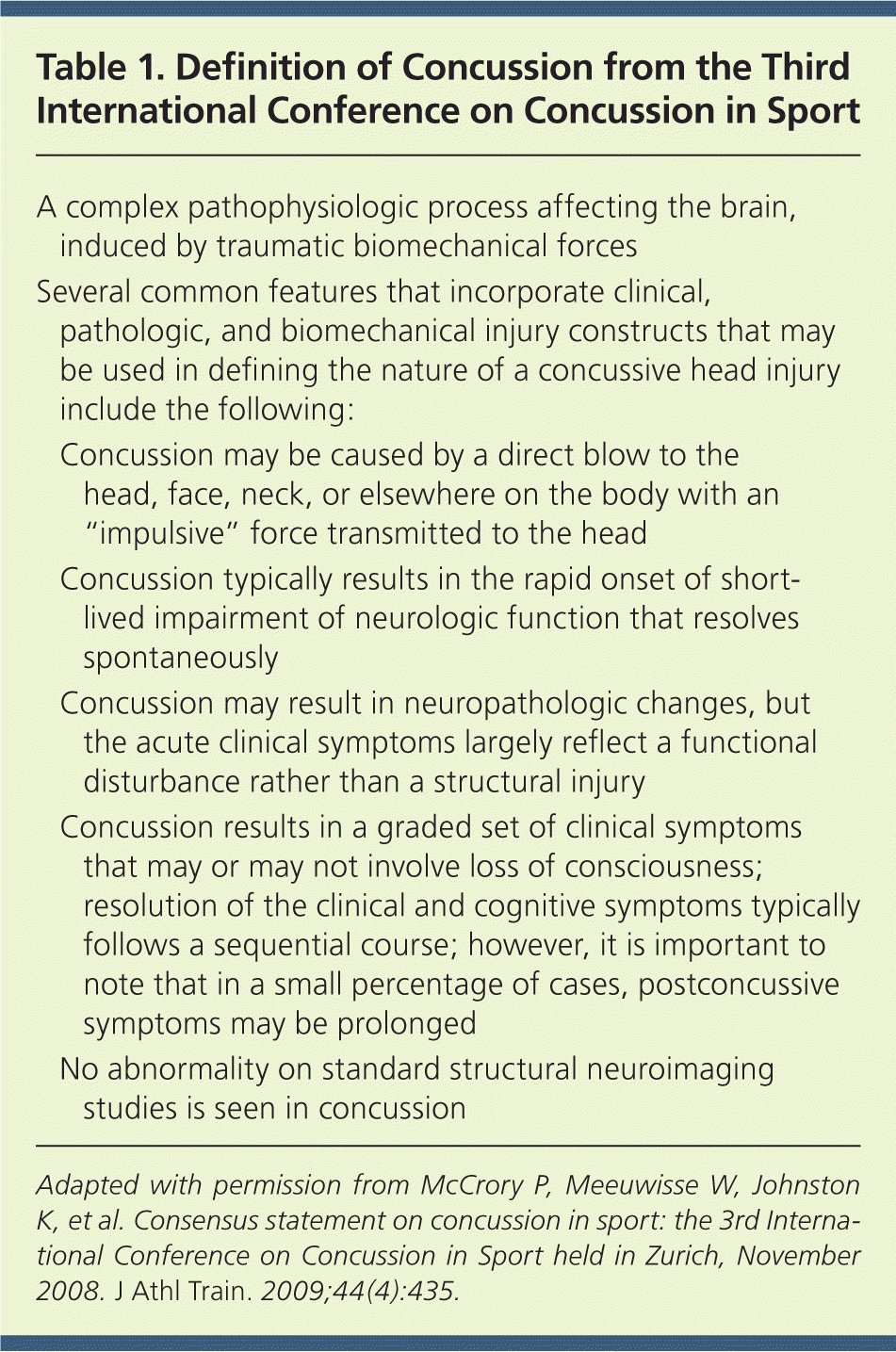
| A complex pathophysiologic process affecting the brain, induced by traumatic biomechanical forces | |
| Several common features that incorporate clinical, pathologic, and biomechanical injury constructs that may be used in defining the nature of a concussive head injury include the following: | |
| Concussion may be caused by a direct blow to the head, face, neck, or elsewhere on the body with an “impulsive” force transmitted to the head | |
| Concussion typically results in the rapid onset of short-lived impairment of neurologic function that resolves spontaneously | |
| Concussion may result in neuropathologic changes, but the acute clinical symptoms largely reflect a functional disturbance rather than a structural injury | |
| Concussion results in a graded set of clinical symptoms that may or may not involve loss of consciousness; resolution of the clinical and cognitive symptoms typically follows a sequential course; however, it is important to note that in a small percentage of cases, postconcussive symptoms may be prolonged | |
| No abnormality on standard structural neuroimaging studies is seen in concussion | |
Concussion is a common injury that has emerged as a major health care concern in the United States.2–6 Emergency departments report more than 1 million visits annually for traumatic brain injuries, most of which are concussions.2 However, this is likely underreported because many persons do not seek medical care for head injuries.6–10 The incidence of sports-related concussions is estimated to be 1.6 to 3.8 million annually.5,6,11–14 The danger associated with premature return to play and emerging evidence of long-term consequences of concussions have prompted state and national legislation for youth athletics.15 The legislation has led to new guidelines, expansion of neuropsychological testing, and rule changes for sporting events. Consequently, management of concussions has changed significantly.
Concussion can be difficult to recognize, complicated by the lack of a universal definition. Additionally, there are no direct objective measures for diagnosis or recovery, no treatments with well-documented effectiveness,14,16 and limited empiric prospective data to guide return-to-play decisions.17–19 Clinical judgment, expert guidelines, and available assessment tools must be integrated to establish diagnosis and estimate recovery.14
Presentation
Concussion is a functional rather than structural injury that can affect somatic, cognitive, and affective domains.1,8,10,20 Sleep disturbances are also common.10,21 If any of these domains are impaired, concussion should be considered1; however, other conditions cause similar symptoms (e.g., heat illness, exertional migraines, sleep disorders).9,10,16 To diagnose a concussion, a temporal relationship between an appropriate mechanism of injury and onset or worsening of symptoms must be established.10
Headache is the most common symptom of concussion.9,14,22,23 Other common symptoms include dizziness, balance disturbances, and disorientation.14,16,22–24 Loss of consciousness, once considered a hallmark of concussion, occurs in less than 10 percent of patients.9,12,16,22 Selected symptoms of concussion are listed in Table 2.5,8–10,12,16,19–21,23,25
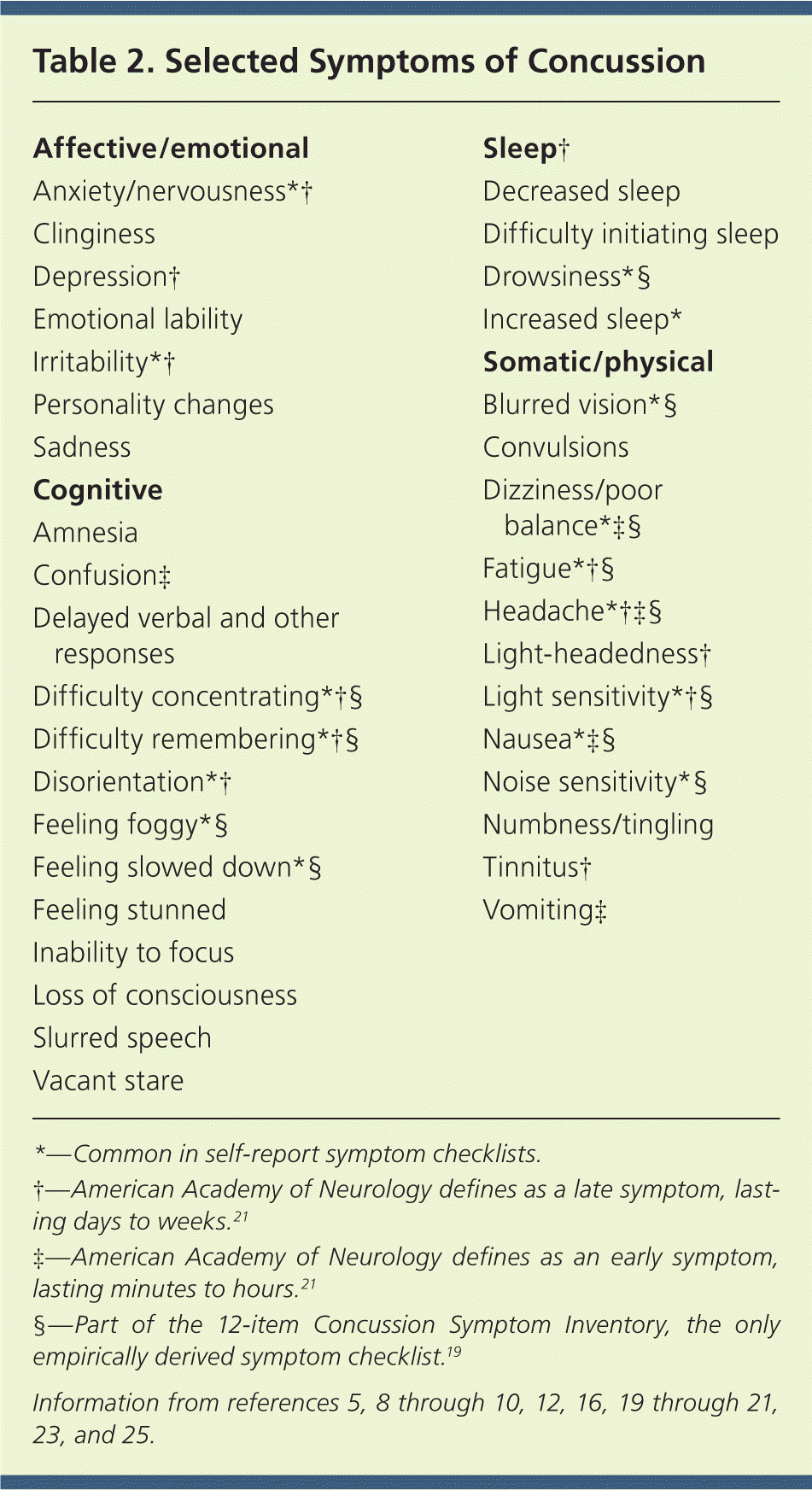
| Affective/emotional |
| Anxiety/nervousness*† |
| Clinginess |
| Depression† |
| Emotional lability |
| Irritability*† |
| Personality changes |
| Sadness |
| Cognitive |
| Amnesia |
| Confusion‡ |
| Delayed verbal and other responses |
| Difficulty concentrating*†§ |
| Difficulty remembering*†§ |
| Disorientation*† |
| Feeling foggy*§ |
| Feeling slowed down*§ |
| Feeling stunned |
| Inability to focus |
| Loss of consciousness |
| Slurred speech |
| Vacant stare |
| Sleep† |
| Decreased sleep |
| Difficulty initiating sleep |
| Drowsiness*§ |
| Increased sleep* |
| Somatic/physical |
| Blurred vision*§ |
| Convulsions |
| Dizziness/poor balance*ठ|
| Fatigue*†§ |
| Headache*†‡§ |
| Light-headedness† |
| Light sensitivity*†§ |
| Nausea*ठ|
| Noise sensitivity*§ |
| Numbness/tingling |
| Tinnitus† |
| Vomiting‡ |
Classification
There is no consensus regarding classification of concussions.2,9 Although numerous severity scales exist, none are validated scientifically.12,26 Previous classification systems (e.g., Cantu, American Academy of Neurology) focused on loss of consciousness and amnesia; however, research has demonstrated that such markers do not accurately reflect concussion severity or recovery.8–10,12,14,20 The International Conference on Concussion in Sport proposed classification based on simple versus complex presentations; however, this was applied retrospectively and therefore was not an acceptable guide to treatment.1
An ideal classification system would determine severity at the time of injury, provide prognostic information, and help guide return-to-play decisions. Because such a system does not exist, an individualized approach of monitoring symptoms to resolution is recommended, followed by a graded return-to-play strategy.1,5,8,20
Pathophysiology
Previously, most reported concussions were a result of falls or motor vehicle collisions.2 Recent studies of younger populations suggest most concussions occur during sporting events,4,26 with greatest risk during competitions.3,9,20 Although there are no definitive data on whether males or females are at greater risk of concussions, different mechanisms of injury have been suggested. Males seem prone to concussion through player-to-player contact, whereas concussions in females tend to be caused by contact with the playing surface or equipment.27
Concussion is caused by rotational and angular forces to the brain, and direct impact to the head is not required.9,10,12,20 Shear forces disrupt neural membranes, allowing potassium efflux into extracellular space. Resultant increases of calcium and excitatory amino acids are followed by further potassium efflux, leading to suppression of neuron activity.8–10,12,20 As sodium-potassium pumps restore balance, there is increased energy requirement, yet a paradoxical decrease in cerebral blood flow. Disruptions of autonomic regulation can persist for several weeks, and the brain may be vulnerable to additional injury.12,28
Natural History
Symptoms of concussion typically present immediately after injury, but may be delayed several hours.10,16,21 Concussion symptoms usually last less than 72 hours,16 and most concussions resolve spontaneously within seven to 10 days.1 Recovery may be prolonged in children, adolescents,1,3,9,12,17 and those with previous concussions.23,29
Assessment of symptoms has traditionally been used to monitor recovery; however, the role of cognitive dysfunction has received significant attention. Although described inconsistently in the literature,14 cognitive function likely recovers independently of symptoms. This raises concern for increased risk of additional injury even after symptoms have resolved.
Factors predictive of recovery are poorly defined. Traditional markers (i.e., loss of consciousness, amnesia, convulsions) were extrapolated from data of more severe traumatic brain injuries. Studies have demonstrated that brief loss of consciousness is not associated with prolonged recovery,1,8,26 and that convulsions immediately after injury are benign.26 The significance of amnesia is less clear. Recent findings suggest that prolonged headache (more than 60 hours), fatigue, tiredness, fogginess, or presence of more than three symptoms at presentation may be associated with prolonged recovery.14
Assessment Tools
Most concussions lead to subtle changes; therefore, evaluation can be challenging.9,30 Numerous assessment tools exist to aid diagnosis and management (Table 3).1,5,16,18,19,30,31 Although none are exclusively effective,8 combining tools increases sensitivity and specificity.1,16,31 Assessment tools are most beneficial when baseline measurements are available for comparison.8
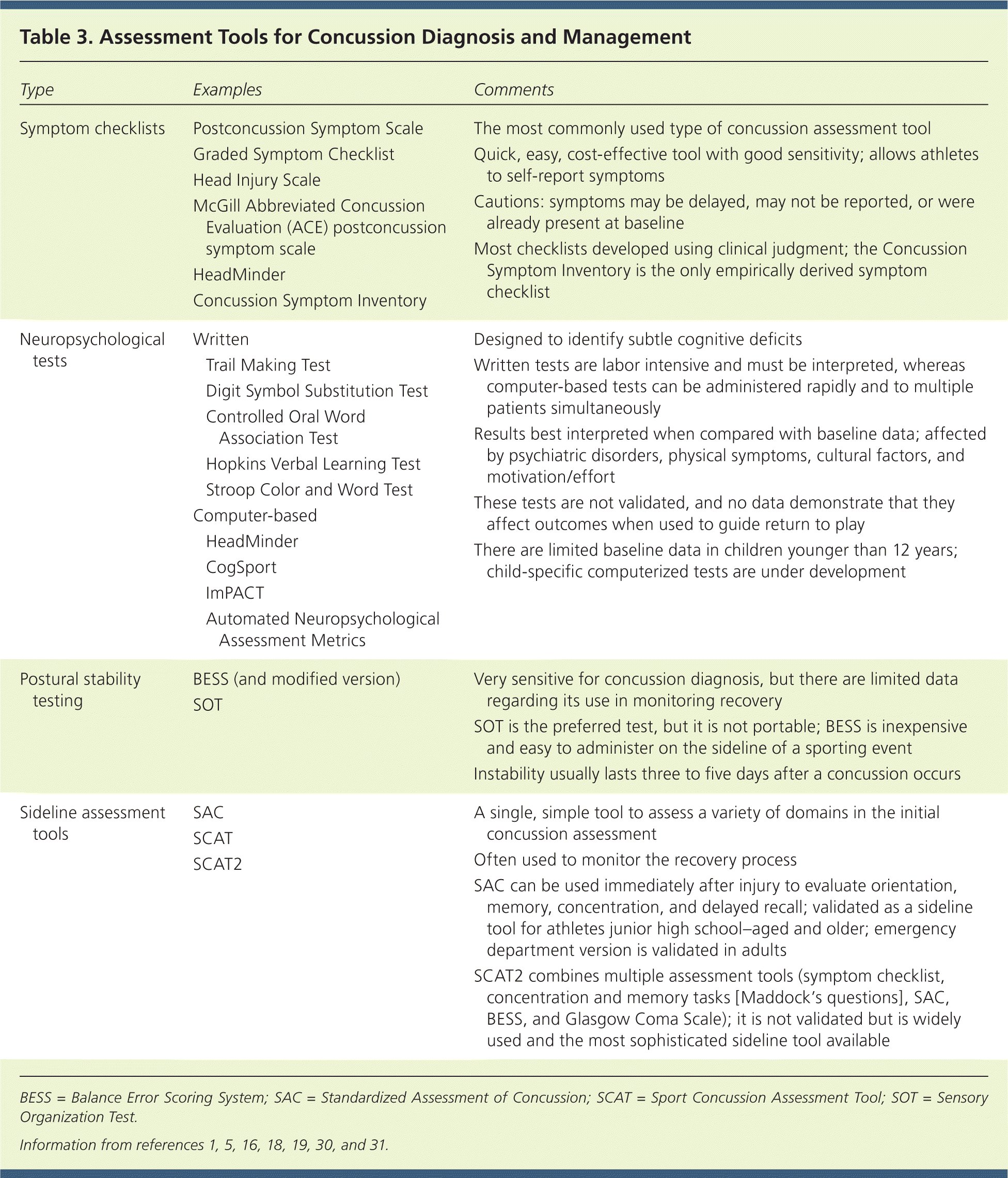
| Type | Examples | Comments | |
|---|---|---|---|
| Symptom checklists |
| The most commonly used type of concussion assessment tool | |
| Quick, easy, cost-effective tool with good sensitivity; allows athletes to self-report symptoms | |||
| Cautions: symptoms may be delayed, may not be reported, or were already present at baseline | |||
| Most checklists developed using clinical judgment; the Concussion Symptom Inventory is the only empirically derived symptom checklist | |||
| Neuropsychological tests |
| Designed to identify subtle cognitive deficits | |
| Written tests are labor intensive and must be interpreted, whereas computer-based tests can be administered rapidly and to multiple patients simultaneously | |||
| Results best interpreted when compared with baseline data; affected by psychiatric disorders, physical symptoms, cultural factors, and motivation/effort | |||
| These tests are not validated, and no data demonstrate that they affect outcomes when used to guide return to play | |||
| There are limited baseline data in children younger than 12 years; child-specific computerized tests are under development | |||
| Postural stability testing |
| Very sensitive for concussion diagnosis, but there are limited data regarding its use in monitoring recovery | |
| SOT is the preferred test, but it is not portable; BESS is inexpensive and easy to administer on the sideline of a sporting event | |||
| Instability usually lasts three to five days after a concussion occurs | |||
| Sideline assessment tools |
| A single, simple tool to assess a variety of domains in the initial concussion assessment | |
| Often used to monitor the recovery process | |||
| SAC can be used immediately after injury to evaluate orientation, memory, concentration, and delayed recall; validated as a sideline tool for athletes junior high school–aged and older; emergency department version is validated in adults | |||
| SCAT2 combines multiple assessment tools (symptom checklist, concentration and memory tasks [Maddock's questions], SAC, BESS, and Glasgow Coma Scale); it is not validated but is widely used and the most sophisticated sideline tool available | |||
SYMPTOM CHECKLISTS
Most guidelines primarily recommend checklists that allow for patients to self-report their concussion symptoms16,19; however, symptoms may be delayed, may not be reported, or were already present at baseline.1,16 Most checklists have been developed through clinical experience and have significant similarities, yet none are considered superior.19,24
NEUROPSYCHOLOGICAL TESTING
Neuropsychological tests are designed to identify subtle cognitive deficits. Written tests are labor-intensive and require trained administrators, whereas computer-based tests allow for rapid administration to multiple patients simultaneously.16 There is no consensus on which tests are most effective.5,9,10,19,20,25 A meta-analysis found no statistically significant difference in sensitivity 14 days after injury among written tests, computer-based tests, and the Standardized Assessment of Concussion (SAC; a sideline assessment tool).30 Neuropsychological testing is often considered the cornerstone of concussion evaluation; however, there is no evidence that it affects outcomes.5,9,10,12,19,20 There is also disagreement on the degree of recovery necessary for safe return to play.25
POSTURAL STABILITY TESTING
Concussion leads to impaired balance, which typically lasts three to five days.1,5,16,26,31 Postural stability testing is an integral part of evaluation1; however, there is insufficient evidence on its use.31 Some balance testing requires sophisticated equipment; however, the Balance Error Scoring System requires only a foam block and can be performed on the sideline of an athletic event.
SIDELINE ASSESSMENT TOOLS
Common sideline tools include the SAC and Sport Concussion Assessment Tool 2 (SCAT2). These tools assess several domains to diagnose concussion and monitor recovery. The SAC has been validated in athletes who are junior high school–aged and older. Emergency department versions are validated in adults, although they are not optimal for use in children.29 The SCAT2 has not been validated; however, it is widely used and the most sophisticated sideline assessment tool available.18 The SCAT2 includes a symptom checklist, concentration and memory tasks (Maddock's questions), the SAC, the Balance Error Scoring System, and the Glasgow Coma Scale.
Initial Evaluation
Figure 1 is a suggested algorithm for the evaluation of concussion.1,2,5,8,9,12,16,18,21,31,32 For obvious head and neck injuries, assessment begins at the site of injury 1,8,9,12,20 and focuses on evaluating the cervical spine.8 In unconscious persons, cervical spine injury must be assumed.9,12,25 Table 4 includes neurologic examination findings that may indicate more significant traumatic brain injury and the need for hospital evaluation.1,5,10
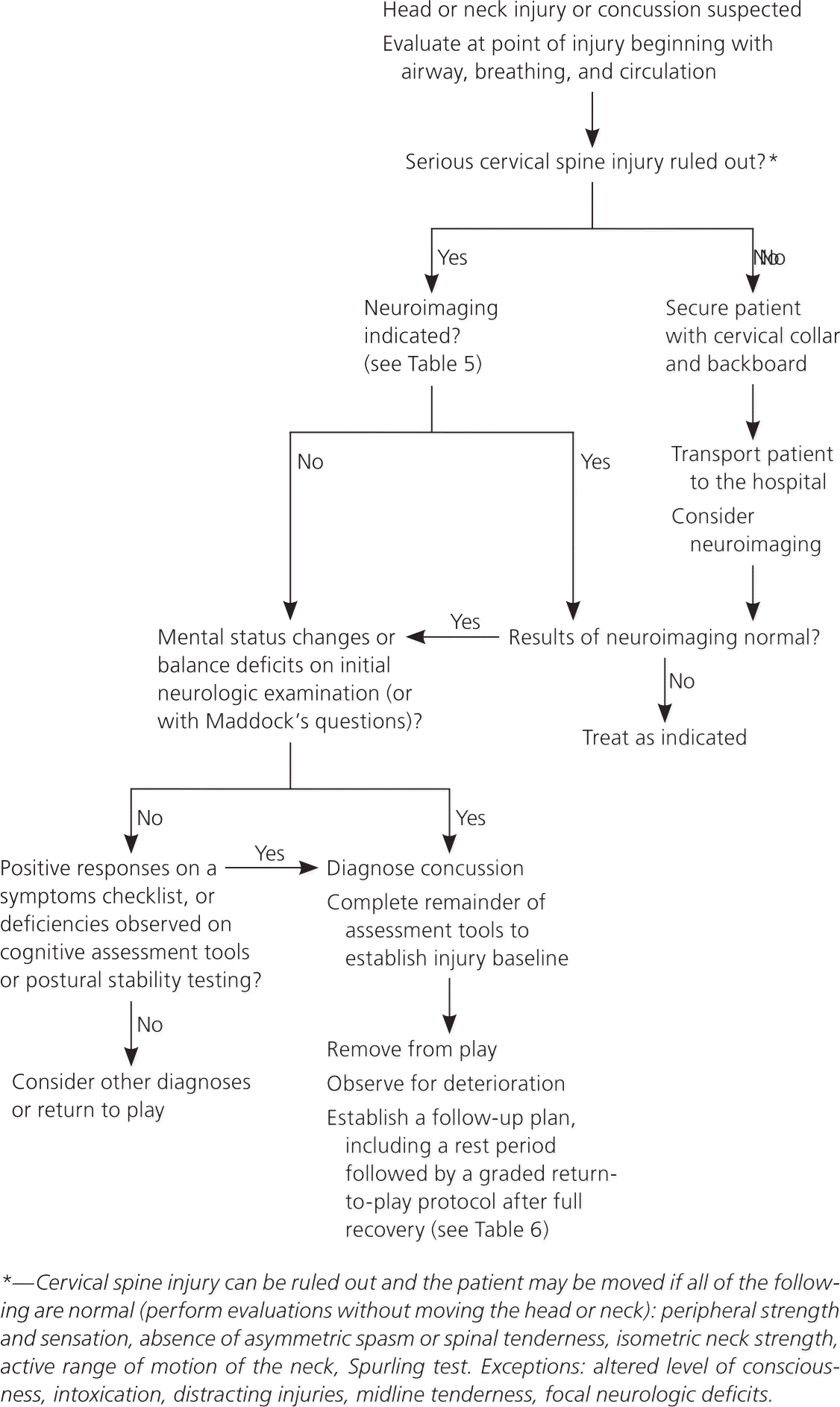
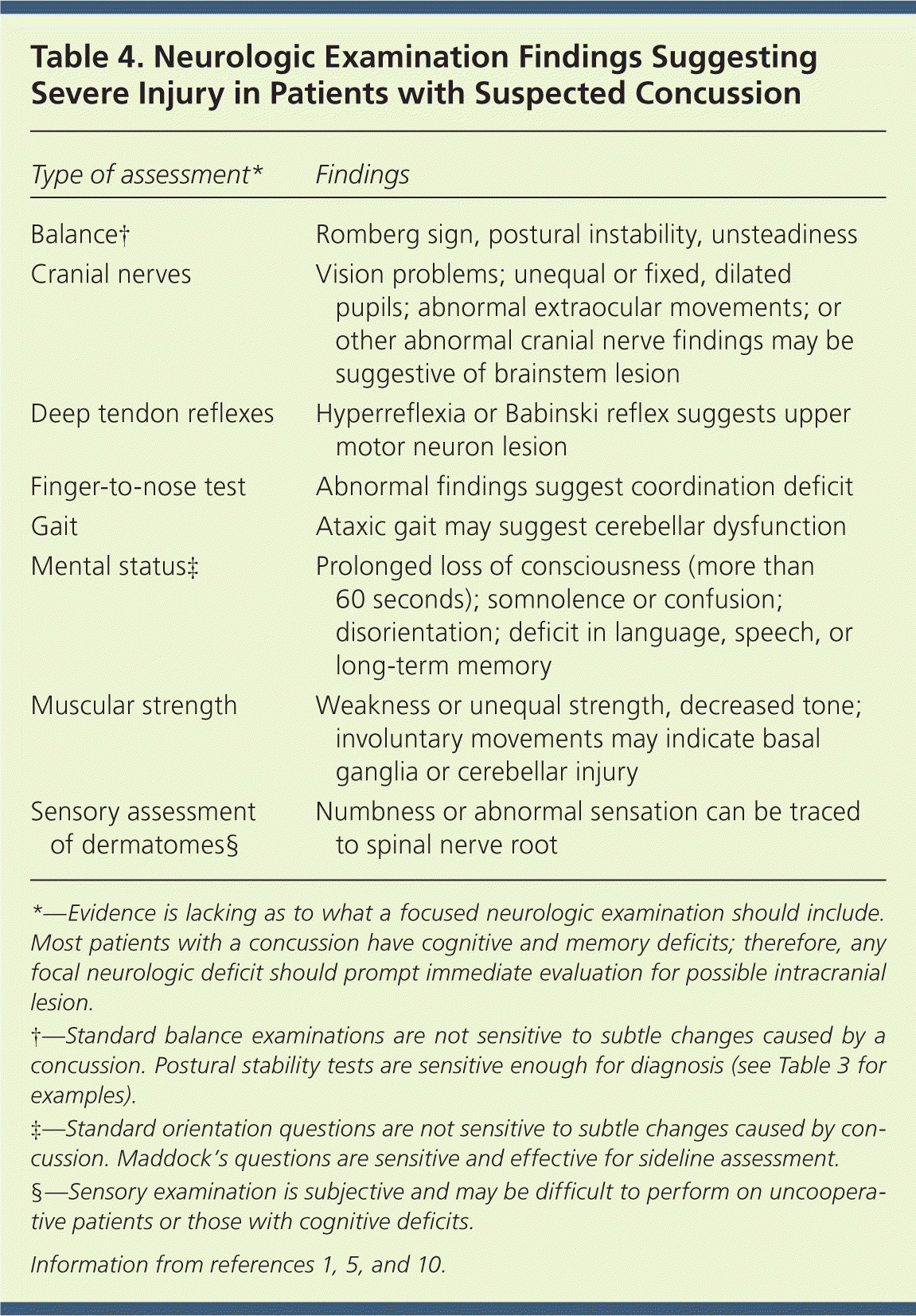
| Type of assessment* | Findings |
|---|---|
| Balance† | Romberg sign, postural instability, unsteadiness |
| Cranial nerves | Vision problems; unequal or fixed, dilated pupils; abnormal extraocular movements; or other abnormal cranial nerve findings may be suggestive of brainstem lesion |
| Deep tendon reflexes | Hyperreflexia or Babinski reflex suggests upper motor neuron lesion |
| Finger-to-nose test | Abnormal findings suggest coordination deficit |
| Gait | Ataxic gait may suggest cerebellar dysfunction |
| Mental status‡ | Prolonged loss of consciousness (more than 60 seconds); somnolence or confusion; disorientation; deficit in language, speech, or long-term memory |
| Muscular strength | Weakness or unequal strength, decreased tone; involuntary movements may indicate basal ganglia or cerebellar injury |
| Sensory assessment of dermatomes§ | Numbness or abnormal sensation can be traced to spinal nerve root |
SIDELINE EVALUATION
Further evaluation can occur on the sideline or in the training room. With concussion, neurologic findings are normal other than mental status and balance deficits; however, subtle changes from a concussion are not identifiable through standard orientation questions or traditional balance testing.1,9,12,20,25 Assessment of a patient with possible concussion should include a physical examination in addition to use of available concussion assessment tools.1,5,8,18 Monitoring for deterioration over several hours is essential.1,8 The athlete should not return to play unless evaluation provides confidence that the patient does not have a concussion.1
HOSPITAL EVALUATION AND IMAGING
Evaluation in the hospital is identical to that on the sideline, but involves a more detailed history and neurologic examination.1 The greatest challenge is determining who requires advanced neuroimaging.1,2 Imaging is often overused and contributes little to management of concussion, other than ruling out more serious traumatic brain injuries, skull fractures, and cervical spine injuries.1,2,5,8,10,12,16,21,32 If it is determined that imaging is warranted (Table 52,32 ), computed tomography is the initial modality of choice because of availability and sensitivity for diagnosing intracranial hemorrhage.2,8,21,32 Magnetic resonance imaging is acceptable acutely, but is more appropriate for evaluation of prolonged deficits.12 Plain radiography of the head has no role in the evaluation of possible concussion.2,32 Newer imaging modalities (e.g., functional magnetic resonance imaging) are under investigation; however, evidence is limited, few are readily available, and none have fully established clinical application.1,5,6,10,12,16,33
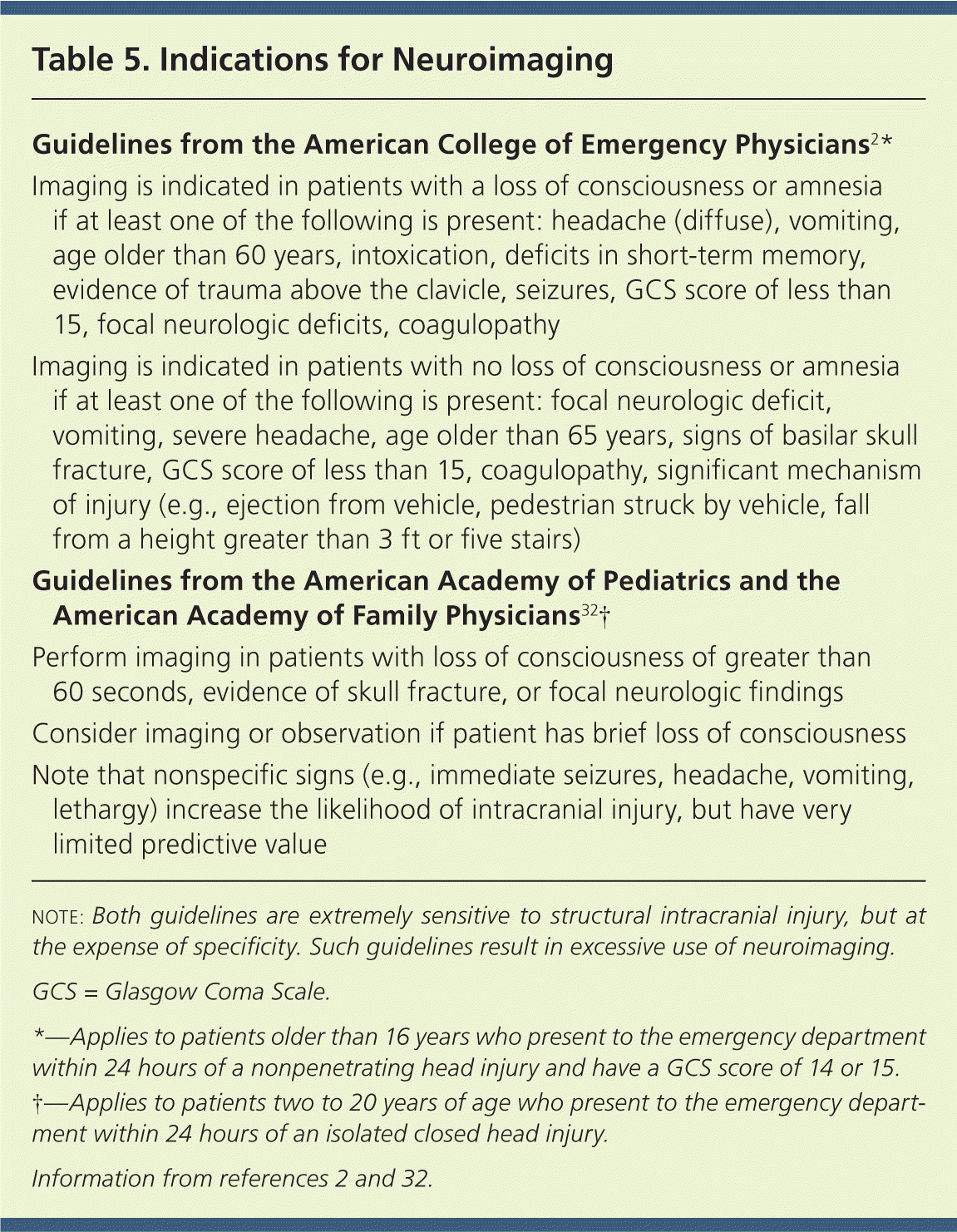
| Guidelines from the American College of Emergency Physicians2 * |
| Imaging is indicated in patients with a loss of consciousness or amnesia if at least one of the following is present: headache (diffuse), vomiting, age older than 60 years, intoxication, deficits in short-term memory, evidence of trauma above the clavicle, seizures, GCS score of less than 15, focal neurologic deficits, coagulopathy |
| Imaging is indicated in patients with no loss of consciousness or amnesia if at least one of the following is present: focal neurologic deficit, vomiting, severe headache, age older than 65 years, signs of basilar skull fracture, GCS score of less than 15, coagulopathy, significant mechanism of injury (e.g., ejection from vehicle, pedestrian struck by vehicle, fall from a height greater than 3 ft or five stairs) |
| Guidelines from the American Academy of Pediatrics and the American Academy of Family Physicians32 † |
| Perform imaging in patients with loss of consciousness of greater than 60 seconds, evidence of skull fracture, or focal neurologic findings |
| Consider imaging or observation if patient has brief loss of consciousness |
| Note that nonspecific signs (e.g., immediate seizures, headache, vomiting, lethargy) increase the likelihood of intracranial injury, but have very limited predictive value |
If the patient has no significant cervical spine or intracranial injury, home care with observation is appropriate provided there is a responsible caretaker and sufficient ability to seek medical care if needed; the patient and caretaker should receive written instructions on when to seek medical attention.2,12,32 Follow-up is necessary because return-to-play decisions cannot be made acutely.4,8 Periodic wakening is controversial; although this practice may allow for detection of progressive neurologic decline, sleep deprivation may exacerbate concussion symptoms.12
Management
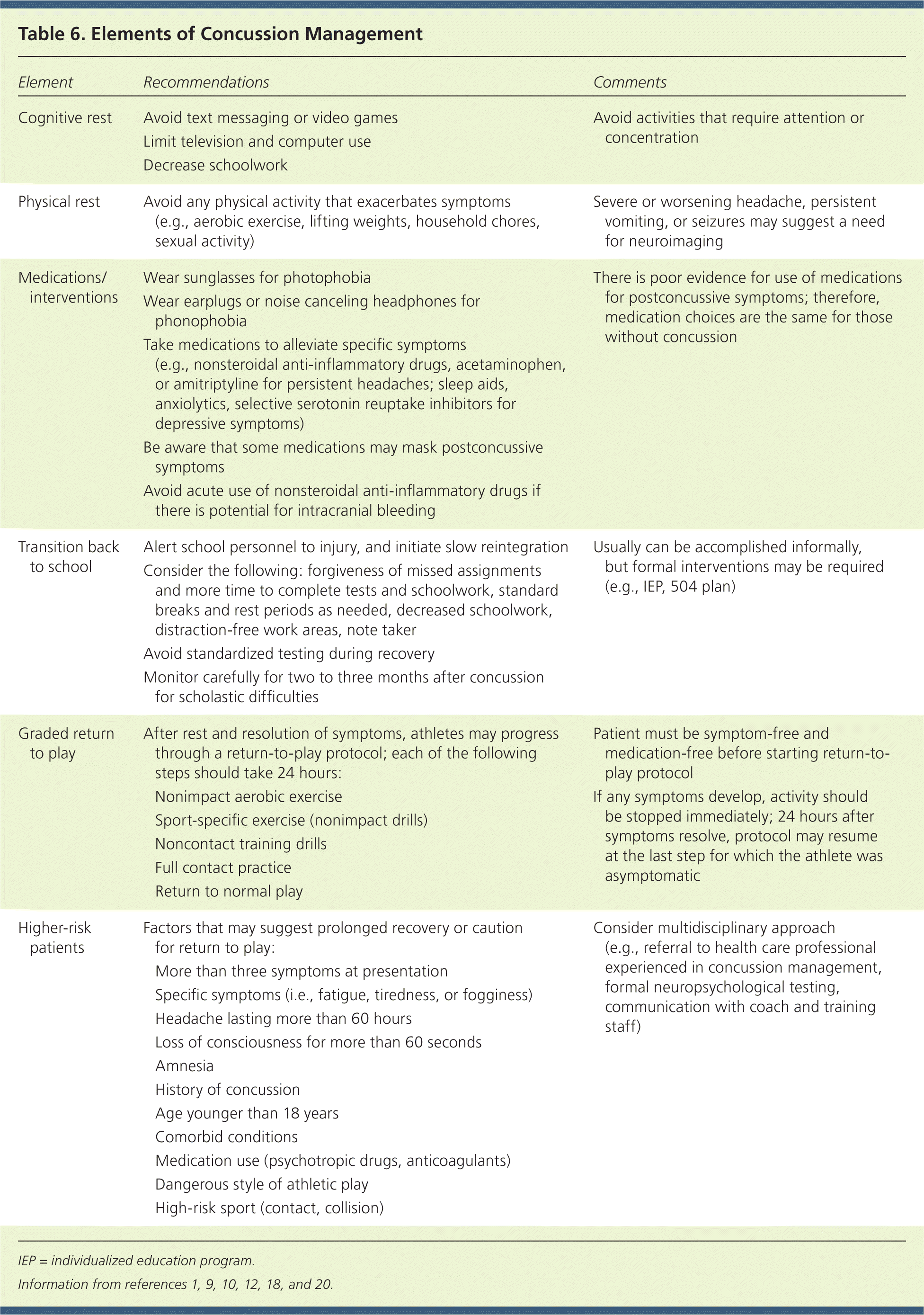
| Element | Recommendations | Comments |
|---|---|---|
| Cognitive rest | Avoid text messaging or video games | Avoid activities that require attention or concentration |
| Limit television and computer use | ||
| Decrease schoolwork | ||
| Physical rest | Avoid any physical activity that exacerbates symptoms (e.g., aerobic exercise, lifting weights, household chores, sexual activity) | Severe or worsening headache, persistent vomiting, or seizures may suggest a need for neuroimaging |
| Medications/interventions | Wear sunglasses for photophobia | There is poor evidence for use of medications for postconcussive symptoms; therefore, medication choices are the same for those without concussion |
| Wear earplugs or noise canceling headphones for phonophobia | ||
| Take medications to alleviate specific symptoms (e.g., nonsteroidal anti-inflammatory drugs, acetaminophen, or amitriptyline for persistent headaches; sleep aids, anxiolytics, selective serotonin reuptake inhibitors for depressive symptoms) | ||
| Be aware that some medications may mask postconcussive symptoms | ||
| Avoid acute use of nonsteroidal anti-inflammatory drugs if there is potential for intracranial bleeding | ||
| Transition back to school | Alert school personnel to injury, and initiate slow reintegration | Usually can be accomplished informally, but formal interventions may be required (e.g., IEP, 504 plan) |
| Consider the following: forgiveness of missed assignments and more time to complete tests and schoolwork, standard breaks and rest periods as needed, decreased schoolwork, distraction-free work areas, note taker | ||
| Avoid standardized testing during recovery | ||
| Monitor carefully for two to three months after concussion for scholastic difficulties | ||
| Graded return to play | After rest and resolution of symptoms, athletes may progress through a return-to-play protocol; each of the following steps should take 24 hours:
| Patient must be symptom-free and medication-free before starting return-to- play protocol If any symptoms develop, activity should be stopped immediately; 24 hours after symptoms resolve, protocol may resume at the last step for which the athlete was asymptomatic |
| Higher-risk patients | Factors that may suggest prolonged recovery or caution for return to play:
| Consider multidisciplinary approach (e.g., referral to health care professional experienced in concussion management, formal neuropsychological testing, communication with coach and training staff) |
Complete cognitive and physical rest are cornerstones of initial management1,9,10,12,18,20 because activity may exacerbate concussion symptoms and delay recovery.1 After resolution of symptoms, postural and cognitive testing (within the SCAT2) can confirm that the patient has recovered completely. A graded return-to-play protocol may then be implemented. Athletes should not return to play until they are completely recovered from the concussion and free of medications that may mask the symptoms of the concussion.1,5,8–10,12,18,20 In those at risk of prolonged recovery, formal neuropsychological testing and referral to a health care professional experienced in concussion management may be considered. Reevaluation several months after recovery is prudent to screen for depressive symptoms.
Evidence regarding pharmacologic therapy is limited. Treatment focuses on symptom management, including the same medications appropriate in patients without a concussion.1,5 Medications that may mask worsening symptoms or confuse changes in mental status should be avoided. Medications that may worsen the potential for intracranial bleeding (e.g., nonsteroidal anti-inflammatory drugs) should be used with caution.
Special Considerations
SAME-DAY RETURN TO PLAY
Athletes should not return to play the same day of sustaining a concussion,1,8,10,18 and most athletic organizations and state laws prohibit it. However, limited data have prompted some to suggest exceptions for professional athletes if sufficient sideline resources exist to assess the athlete and if the athlete demonstrates complete recovery.1,28 This exception does not apply to younger athletes.1,10,12,18
CHILDREN AND ADOLESCENTS
Managing concussion in the developing brain is a unique challenge,12 and the approach must be different than that for adults.11,20 Most research on concussion management applies to persons who are high school–aged or older. Little is known about concussions in children; therefore, conservative management is appropriate (e.g., a longer asymptomatic period before return to play).1,9,11,18,20 Special considerations and recommendations for managing concussions in children are included in Table 7.1,7,9–12,17,18,20
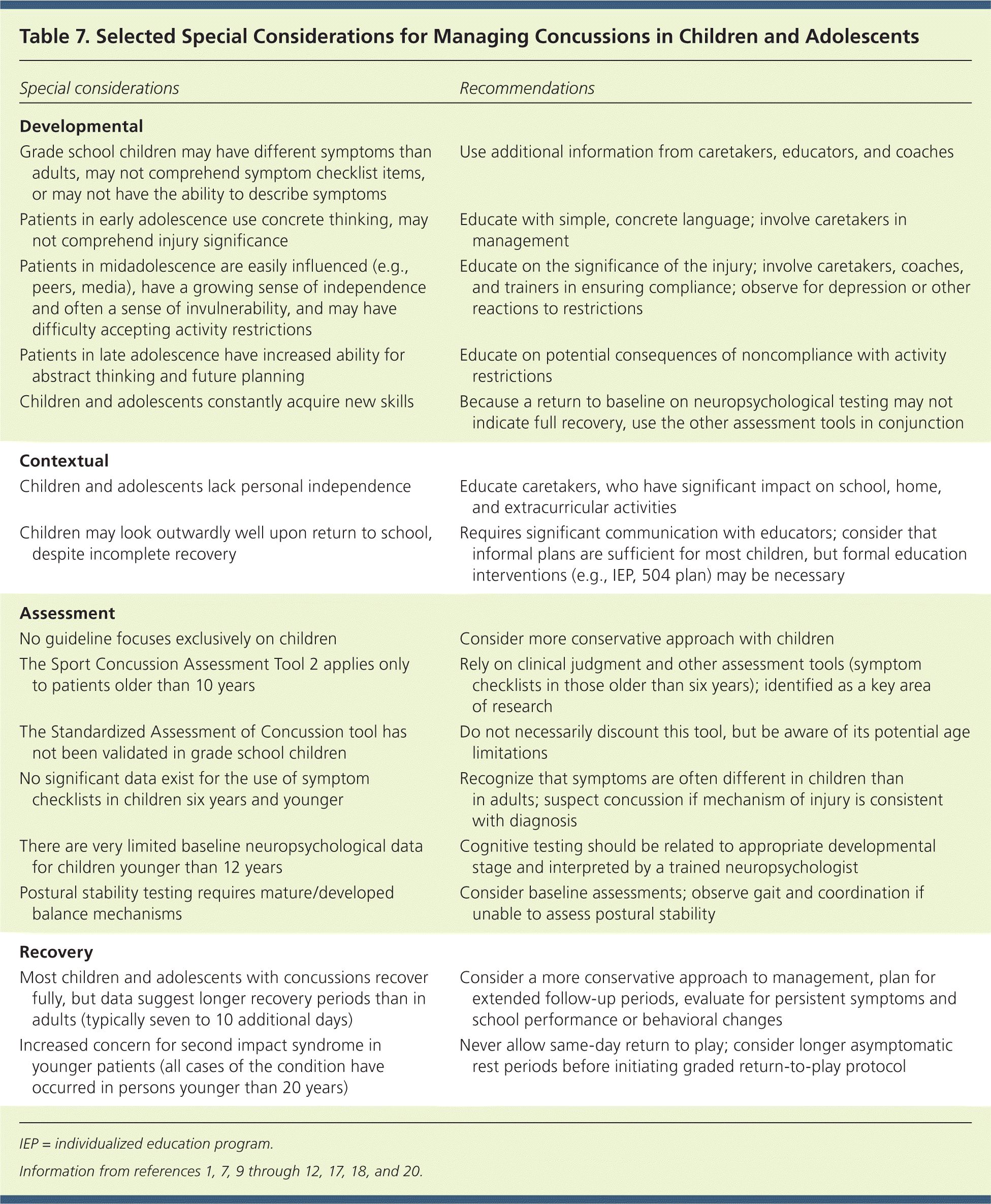
| Special considerations | Recommendations |
|---|---|
| Developmental | |
| Grade school children may have different symptoms than adults, may not comprehend symptom checklist items, or may not have the ability to describe symptoms | Use additional information from caretakers, educators, and coaches |
| Patients in early adolescence use concrete thinking, may not comprehend injury significance | Educate with simple, concrete language; involve caretakers in management |
| Patients in midadolescence are easily influenced (e.g., peers, media), have a growing sense of independence and often a sense of invulnerability, and may have difficulty accepting activity restrictions | Educate on the significance of the injury; involve caretakers, coaches, and trainers in ensuring compliance; observe for depression or other reactions to restrictions |
| Patients in late adolescence have increased ability for abstract thinking and future planning | Educate on potential consequences of noncompliance with activity restrictions |
| Children and adolescents constantly acquire new skills | Because a return to baseline on neuropsychological testing may not indicate full recovery, use the other assessment tools in conjunction |
| Contextual | |
| Children and adolescents lack personal independence | Educate caretakers, who have significant impact on school, home, and extracurricular activities |
| Children may look outwardly well upon return to school, despite incomplete recovery | Requires significant communication with educators; consider that informal plans are sufficient for most children, but formal education interventions (e.g., IEP, 504 plan) may be necessary |
| Assessment | |
| No guideline focuses exclusively on children | Consider more conservative approach with children |
| The Sport Concussion Assessment Tool 2 applies only to patients older than 10 years | Rely on clinical judgment and other assessment tools (symptom checklists in those older than six years); identified as a key area of research |
| The Standardized Assessment of Concussion tool has not been validated in grade school children | Do not necessarily discount this tool, but be aware of its potential age limitations |
| No significant data exist for the use of symptom checklists in children six years and younger | Recognize that symptoms are often different in children than in adults; suspect concussion if mechanism of injury is consistent with diagnosis |
| There are very limited baseline neuropsychological data for children younger than 12 years | Cognitive testing should be related to appropriate developmental stage and interpreted by a trained neuropsychologist |
| Postural stability testing requires mature/developed balance mechanisms | Consider baseline assessments; observe gait and coordination if unable to assess postural stability |
| Recovery | |
| Most children and adolescents with concussions recover fully, but data suggest longer recovery periods than in adults (typically seven to 10 additional days) | Consider a more conservative approach to management, plan for extended follow-up periods, evaluate for persistent symptoms and school performance or behavioral changes |
| Increased concern for second impact syndrome in younger patients (all cases of the condition have occurred in persons younger than 20 years) | Never allow same-day return to play; consider longer asymptomatic rest periods before initiating graded return-to-play protocol |
MULTIPLE CONCUSSIONS
Epidemiologic studies suggest long-term cognitive deficits with multiple concussions; however, medical research is conflicting.7,9,10,23,25,26 Those with previous concussions have increased risk of recurrent injury9,10,20,23,25 and have longer recovery periods.7,9,20,23,25,29 There are no guidelines regarding athletic disqualification or retirement; however, it may be prudent to disqualify athletes who sustain concussions with increasing frequency or in response to decreased impact.
SECOND IMPACT SYNDROME
Second impact syndrome can occur if an athlete returns to play before full resolution of a concussion.28 After a concussion, the brain may be susceptible to extremes of blood pressure.17,28 A catecholamine surge from a second impact to the head or body may cause vascular congestion, cerebral edema, increased intracranial pressure, and ultimately coma or death.8,10,12,20,25,28 There are few documented cases,19,25 but all have occurred in persons younger than 20 years.8,12 Although the existence of second impact syndrome is controversial,10,28 it is universally accepted that no athlete should return to play after a concussion while symptomatic.9,10
Prevention, Education, and Legislation
There is no evidence that protective gear prevents concussions.1,8–10,12,33 Helmets and mouth guards reduce risk of skull and dental fractures, but neither has been demonstrated to reduce the incidence of concussion.8,12,33 Rule changes to eliminate dangerous behaviors in sports may have a more protective effect.
Education may reduce violence in sports and allow early recognition of concussion symptoms to prevent further injury.8 The Centers for Disease Control and Prevention has instituted the Heads Up campaign to promote concussion education. Educational and clinical management tools are available at http://cdc.gov/concussion/headsup.
In 2009, Washington State enacted the Zackery Lystedt Law requiring concussion education for coaches, athletes, and parents.15 The law also mandates removal of athletes from activity if there is any suspicion of concussion, and return to play must be cleared by a licensed health care professional. Other states have since enacted similar legislation.34
Data Sources: A PubMed search was completed in Clinical Queries using the key terms concussion, traumatic brain injury, and brain injury, with additional searches narrowed by the terms epidemiology, assessment, evaluation, management, treatment, and imaging. The search included meta-analyses, randomized controlled trials, clinical trials, and reviews. Also searched were the Cochrane database, Clinical Evidence, National Guideline Clearinghouse, Agency for Healthcare Research and Quality Evidence Reports, and UpToDate. Search dates: September 30, 2010, and October 31, 2010.
